In the fall semester, Kati and I decided to work together because we realized that although our students seem to be different – hers being elementary school kids and mine being adult ELL newcomers to Canada – they are in fact quite similar in their diversity and unique learning needs.
Last semester as we began investigating how we could support our students by using their lived experience to optimize this learning divergence, we discovered the Inclusive Design for Learning Framework where Watkins et al. describe its goal as “… to support diversity and variability by co-creating “one-size-fits-one” learning experiences within an integrated learning environment”(2020, p.2).
As we continued our research, we picked up a few articles from Jutta Treviranus, the founder and director of the Inclusive Design Research Centre at OCAD University, who had collaborated with Watkins on the framework. Her article Realizing the Potential of Inclusive Education (2018), emphasizes that inclusive education has a critical role in addressing disparities and realizing the potential of human diversity. She writes about a growing disparity in wealth, education, employment, research, and digital access, and these inequalities are made worse by technologies like search engine optimization, social media, and big data analytics, creating echo chambers of popularity and attention. She notes that “investing in inclusive education and education about inclusion can address these disparities and have a multiplying effect beyond the initial effort” (p.1).
The Ant Death Spiral
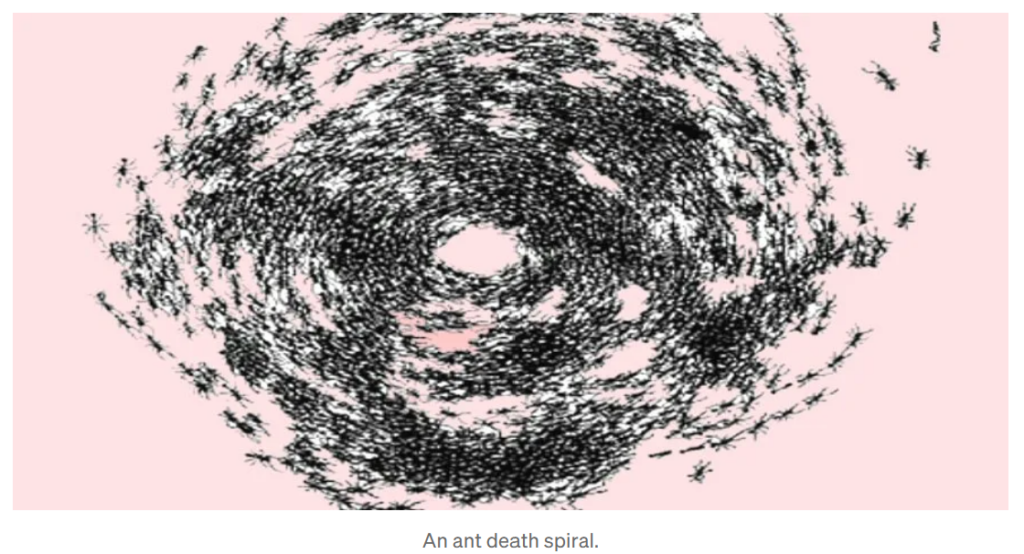
Throughout her blog posts, Treviranus presents many interesting visuals. One of the first that caught my eye was that of the ant death spiral from her post Recount 15: Seeking True Innovation.
This image caught my attention and stayed with me while reading. Why are the ants doing this? Why does this spiral occur?
Are these lost ants the outliers of learning and the teachers chasing them, trying to get them to learn with standardized content? Or does this represent the echo chambers of social media and technology mentioned above – exposure to opinions and information that only reinforce current beliefs and make it hard to see different perspectives? Though Treviranus does not directly address this fascinating image, I know that there must be an instructive purpose.
On a personal level, ants do fascinate me. I spent a lot of time in my childhood at our family cottage in Northern Ontario. My brother, cousins, and I would spend hours watching ants in the sandbox, running over the ant hills on the front lawn with our bikes, watching ants drag pieces of food, admiring their different shades of brown and deep red as well as their range in sizes, and we also often had our ankles bitten by whichever kind bites when we least expected it.
Two years ago, when I visited the cottage, my aunt was perturbed that a certain kind of larger ant was getting inside. She had traps in all corners. One afternoon, we witnessed an ant carrying another dead ant. When we looked it up, we learned that ants do have undertakers to take their dead back to their nests! Fascinating. Perhaps this is why I was drawn to the ant death spiral.
Diversity Is Our Strength
“There is no average human, we are all diverse. Our diversity is our strength. What we should be seeking is the range of what we call the deviation, the amazing spectrum of human differences.”
Treviranus (2022)
Treviranus writes in her paper, “Diversity increases complexity. Diversity also increases choices. The edges, where diversity is the highest, offer the greatest untapped potential”(2018, p.6).
In my day-to-day teaching the diversity is obvious, but it is sometimes challenging with a class of 25 – 30 students, to see that this diversity is actually the strength. Similar to keeping perspective in difficult situations, remembering to look at the human differences in my class as an amazing spectrum of lived experience is something I need to remind myself to do.
The Starburst
Treviranus uses the starburst image on her blog post Inclusive Design: The Bell Curve, The Starburst, and the Virtuous Tornado to illustrate that more diversity exists at the edge where needs are inadequately met.
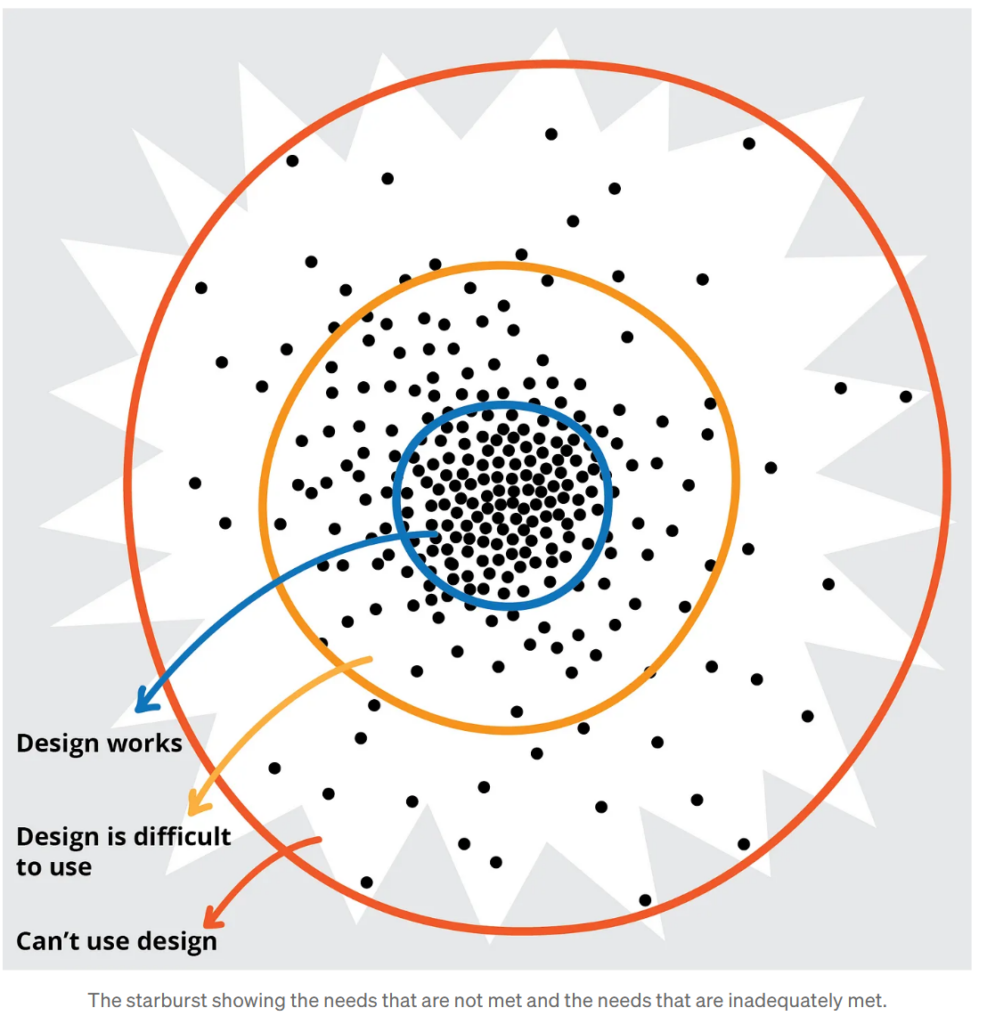
Treviranus, J. (2019, May 12). Inclusive design: The bell curve, the starburst and the virtuous tornado. Medium. https://medium.com/@jutta.trevira/inclusive-design-the-bell-curve-the-starburst-and-the-virtuous-tornado-6094f797b1bf
She says that, “Because the dominant trend is to design for the average, typical or mass, this difference causes a mismatch between the needs of the individual that is different, and the design of the environment, product or service: which results in the experience of disability”. She also notes that anyone can find themselves at the edge and experiencing a mismatch (2019).
I have definitely felt mismatched more than a few times in my own personal learning journey. Some things that come to mind that just haven’t clicked for me: Roman numerals in elementary school, high school calculus and physics, most sports, Kanji, renaissance drama class in university, and cooking!
The 80/20 rule
On her blog Treviranus explains the 80/20 rule. Writing that, “We are still in the thralls of the 80/20 rule, but we are looking at it backwards if we want innovation.” She goes on to explain that, instead of focusing on the 80% who are easiest to support, we should work with the 20% who face the biggest challenges. This takes more effort upfront but leads to long-term benefits and greater resilience. Instead of just looking for the biggest audience, research should focus on those who are currently underserved (2022).
Check out the video below to see Treviranus talk about the starburst and 80/20 rule.
Inclusive Design
Treviranus explains in her paper that the theory of inclusive design focuses on designing for individuals at these edges or margins, considering their diverse needs and integrating them as co-designers in the process. This approach leads to better and more innovative designs for everyone.
She explains that inclusive design has to balance two important but seemingly opposite goals:
- Creating designs that include everyone – meaning they should work for all people without separating or excluding anyone.
- Making sure designs fit individual needs – recognizing that different people may require different things to fully participate.
The best way to achieve both is by making designs flexible so they can adjust to different users. She notes that this is easier in digital spaces because technology allows for customization and can quickly adapt to different needs. Digital tools also help connect different parts of a system, making it more responsive to users (2018, pp. 6-7).
She recommends that “the design team should consist of a diversity of perspectives. This would mean that learners co-create with diverse peers and experts and that all learners not only consume curriculum but also produce curriculum” (2018, p. 9).
When applying inclusive design to education, the move towards digitally mediated education, open education resources, and personalized learning offers opportunities to remove barriers for marginalized learners. However, these opportunities come with challenges, including the need to address digital exclusion and ensure that all learners’ diverse needs are met (2018).
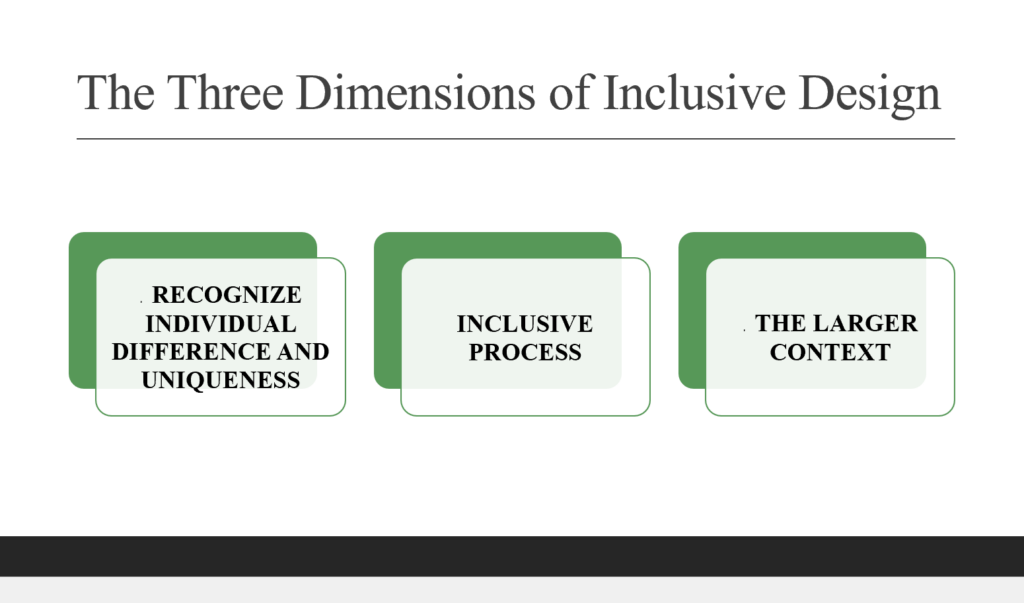
She provides more detail on the three dimensions of inclusive design:
- The first dimension is recognizing individual difference and uniqueness – Design and learning must be individualized. The learner should have control over their decisions.
- The second dimension emphasizes the inclusive process – learners should co-create with diverse peers as well as experts. They consume as well as produce curriculum.
- The third dimension speaks to the larger context – the design and learning process should consider the broader effects of any decisions and aim to create positive change. Learners should understand their unique and growing role within the ever-changing global community.
The Virtuous Tornado
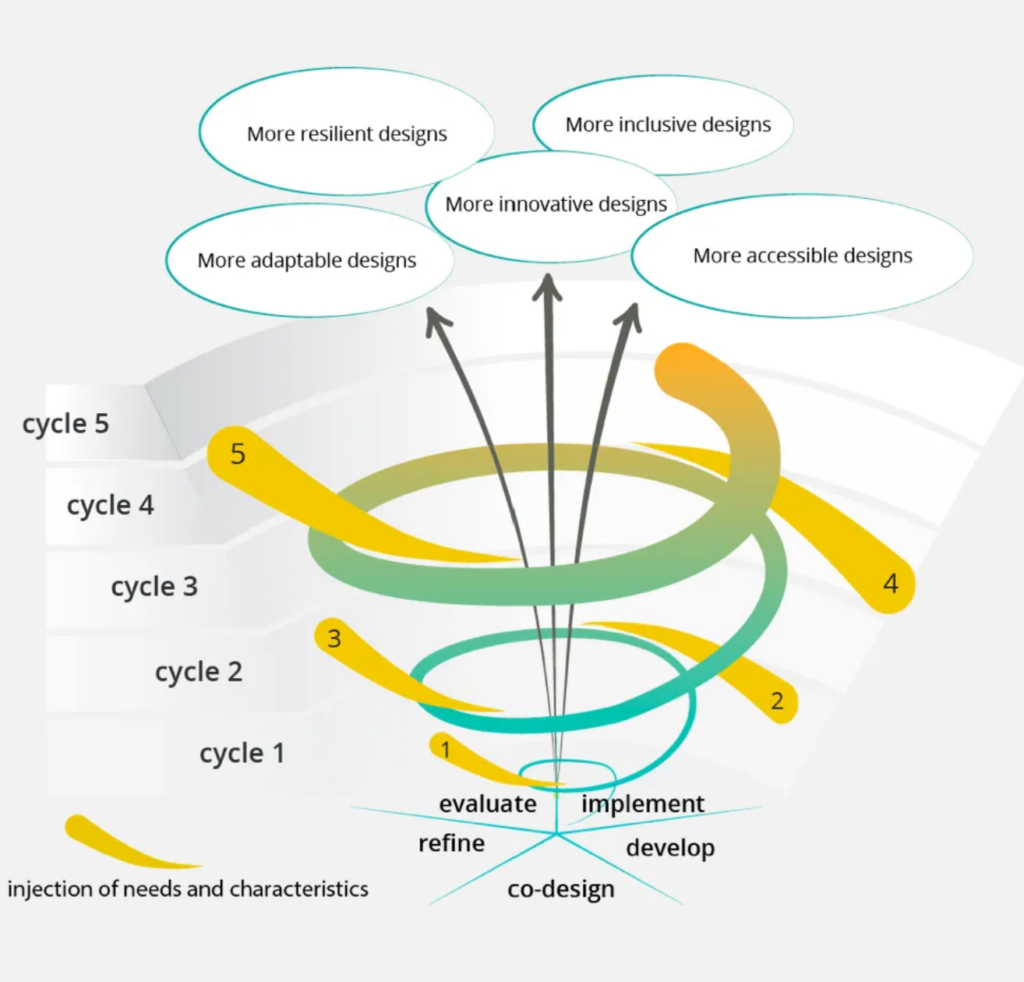
Treviranus applies these dimensions in what she calls a virtuous tornado, where an adaptable system that stretches to encompass more and more of the missed needs is co-created, by continuously asking “who are we missing?” The imperfect, impermanent and incomplete are appreciated, and mistakes and failures yield the greatest learning. Designs become more resilient, more inclusive, move innovative, more adaptable and more accessible (2019).
Conclusions:
And so, Kati and I continue to explore these very questions in our teaching: Who are we missing? And how can we use imperfect mistakes and failures, lived experience, along with multimedia technology to optimize learning for each individual student? Check out our presentation for EDCI 568 in which we try our best to meet all three of the Inclusive Design for Learning Dimensions while experimenting with H5P interactive features.

References:
Treviranus, Jutta (2018) Realizing the potential of inclusive education. In: UNIversal Inclusion. Rights and Opportunities for Students with Disabilities in the Academic Context. Franco Angeli. (In Press) Available at http://openresearch.ocadu.ca/id/eprint/2193/
Treviranus, J. (2019, May 12). Inclusive design: The bell curve, the starburst and the virtuous tornado. Medium. https://medium.com/@jutta.trevira/inclusive-design-the-bell-curve-the-starburst-and-the-virtuous-tornado-6094f797b1bf
Treviranus, J. (2022, September 18). Recount 15: Seeking True Innovation. Medium. https://medium.com/@jutta.trevira/recount-15-seeking-true-innovation-caada6df45c4
Watkins, C., Treviranus, J., & Roberts, V. (2020). Inclusive Design for Learning: Creating Flexible and Adaptable Content with Learners. Commonwealth of Learning (COL). http://hdl.handle.net/11599/3690
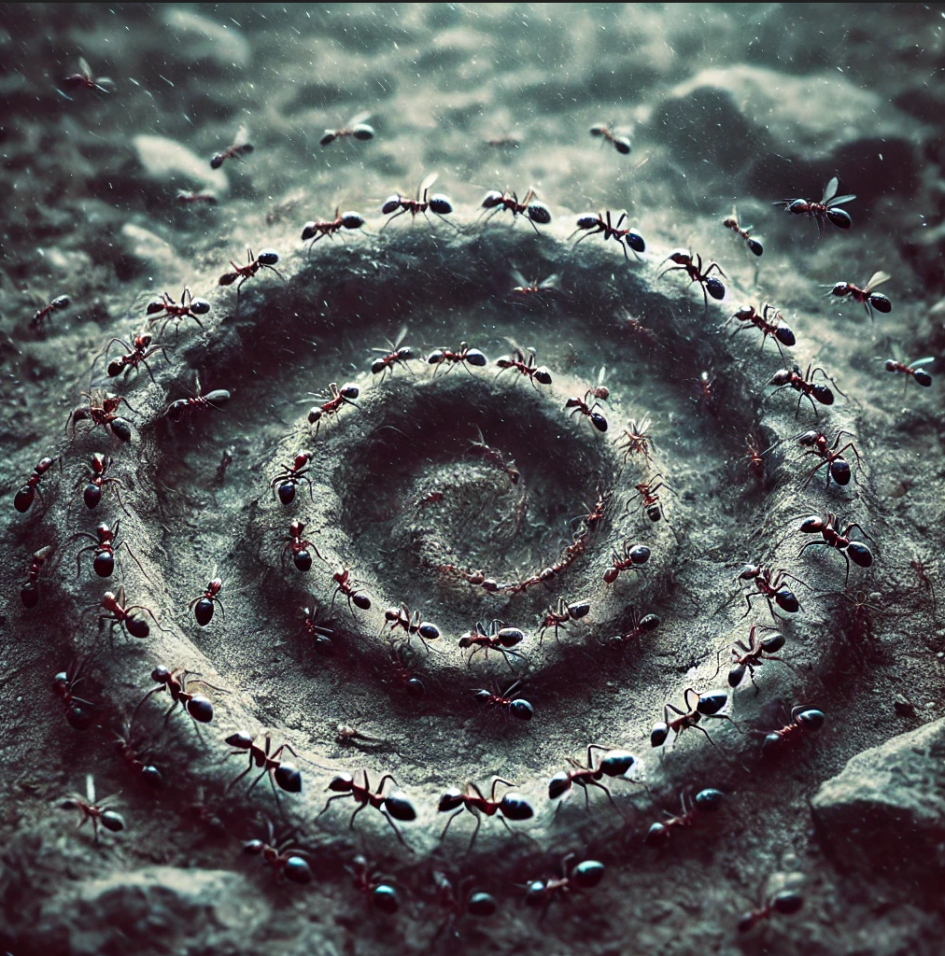
Recent Comments